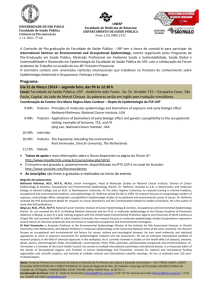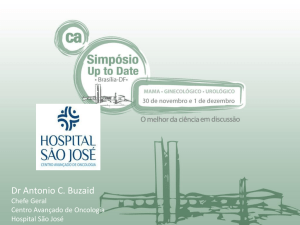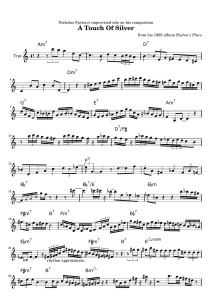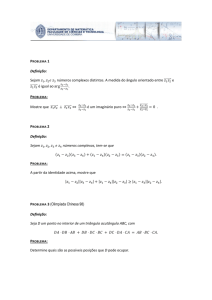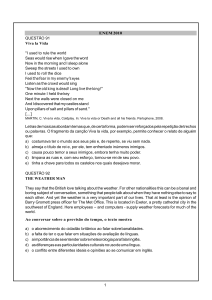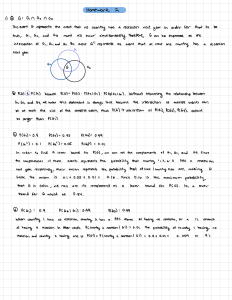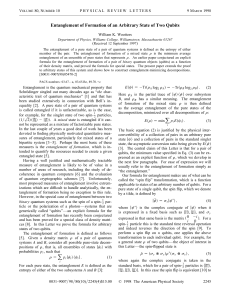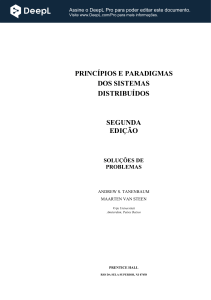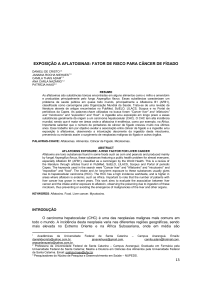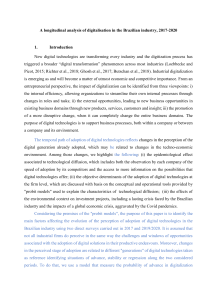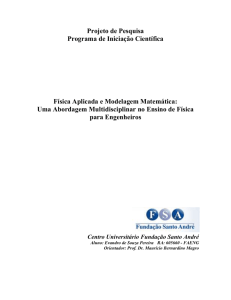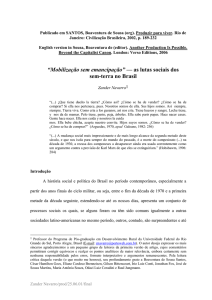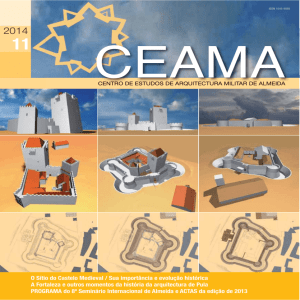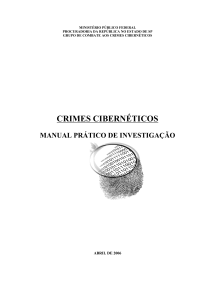Cursinho Comunitário ATHO Simulado Inglês – 19/10/09 UFSCAR
advertisement
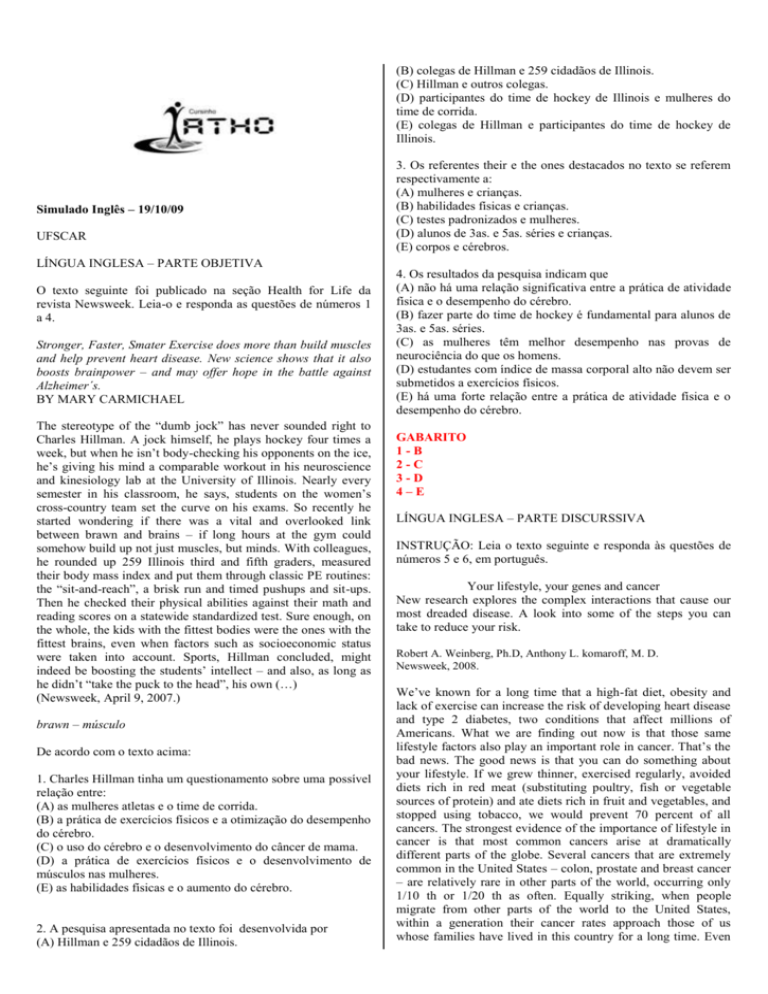
(B) colegas de Hillman e 259 cidadãos de Illinois. (C) Hillman e outros colegas. (D) participantes do time de hockey de Illinois e mulheres do time de corrida. (E) colegas de Hillman e participantes do time de hockey de Illinois. Simulado Inglês – 19/10/09 UFSCAR 3. Os referentes their e the ones destacados no texto se referem respectivamente a: (A) mulheres e crianças. (B) habilidades físicas e crianças. (C) testes padronizados e mulheres. (D) alunos de 3as. e 5as. séries e crianças. (E) corpos e cérebros. LÍNGUA INGLESA – PARTE OBJETIVA O texto seguinte foi publicado na seção Health for Life da revista Newsweek. Leia-o e responda as questões de números 1 a 4. Stronger, Faster, Smater Exercise does more than build muscles and help prevent heart disease. New science shows that it also boosts brainpower – and may offer hope in the battle against Alzheimer´s. BY MARY CARMICHAEL The stereotype of the “dumb jock” has never sounded right to Charles Hillman. A jock himself, he plays hockey four times a week, but when he isn’t body-checking his opponents on the ice, he’s giving his mind a comparable workout in his neuroscience and kinesiology lab at the University of Illinois. Nearly every semester in his classroom, he says, students on the women’s cross-country team set the curve on his exams. So recently he started wondering if there was a vital and overlooked link between brawn and brains – if long hours at the gym could somehow build up not just muscles, but minds. With colleagues, he rounded up 259 Illinois third and fifth graders, measured their body mass index and put them through classic PE routines: the “sit-and-reach”, a brisk run and timed pushups and sit-ups. Then he checked their physical abilities against their math and reading scores on a statewide standardized test. Sure enough, on the whole, the kids with the fittest bodies were the ones with the fittest brains, even when factors such as socioeconomic status were taken into account. Sports, Hillman concluded, might indeed be boosting the students’ intellect – and also, as long as he didn’t “take the puck to the head”, his own (…) (Newsweek, April 9, 2007.) brawn – músculo De acordo com o texto acima: 1. Charles Hillman tinha um questionamento sobre uma possível relação entre: (A) as mulheres atletas e o time de corrida. (B) a prática de exercícios físicos e a otimização do desempenho do cérebro. (C) o uso do cérebro e o desenvolvimento do câncer de mama. (D) a prática de exercícios físicos e o desenvolvimento de músculos nas mulheres. (E) as habilidades físicas e o aumento do cérebro. 2. A pesquisa apresentada no texto foi desenvolvida por (A) Hillman e 259 cidadãos de Illinois. 4. Os resultados da pesquisa indicam que (A) não há uma relação significativa entre a prática de atividade física e o desempenho do cérebro. (B) fazer parte do time de hockey é fundamental para alunos de 3as. e 5as. séries. (C) as mulheres têm melhor desempenho nas provas de neurociência do que os homens. (D) estudantes com índice de massa corporal alto não devem ser submetidos a exercícios físicos. (E) há uma forte relação entre a prática de atividade física e o desempenho do cérebro. GABARITO 1-B 2-C 3-D 4–E LÍNGUA INGLESA – PARTE DISCURSSIVA INSTRUÇÃO: Leia o texto seguinte e responda às questões de números 5 e 6, em português. Your lifestyle, your genes and cancer New research explores the complex interactions that cause our most dreaded disease. A look into some of the steps you can take to reduce your risk. Robert A. Weinberg, Ph.D, Anthony L. komaroff, M. D. Newsweek, 2008. We’ve known for a long time that a high-fat diet, obesity and lack of exercise can increase the risk of developing heart disease and type 2 diabetes, two conditions that affect millions of Americans. What we are finding out now is that those same lifestyle factors also play an important role in cancer. That’s the bad news. The good news is that you can do something about your lifestyle. If we grew thinner, exercised regularly, avoided diets rich in red meat (substituting poultry, fish or vegetable sources of protein) and ate diets rich in fruit and vegetables, and stopped using tobacco, we would prevent 70 percent of all cancers. The strongest evidence of the importance of lifestyle in cancer is that most common cancers arise at dramatically different parts of the globe. Several cancers that are extremely common in the United States – colon, prostate and breast cancer – are relatively rare in other parts of the world, occurring only 1/10 th or 1/20 th as often. Equally striking, when people migrate from other parts of the world to the United States, within a generation their cancer rates approach those of us whose families have lived in this country for a long time. Even Cursinho Comunitário ATHO if people in other parts of the world stay put, but adopt a U. S. lifestyle, their risk of cancer rises; as Japanese have embraced Western habits, their rates of colon, breast and prostate cancer have skyrocketed. What is it about our lifestyle that raises the risk of many types of cancer? The main culprits seem to be the Western diet, obesity and physical inactivity. While we’ve known about the importance of tobacco and cancer for more than 50 years, we are just beginning to understand how diet, a healthy body weight and regular exercise can protect us against cancer. A striking example of the profound influence of diet was reported last summer in The Journal of the American Medical Association. Doctors determined the eating habits of patients with colon cancer in the years following surgical removal of the cancer. Over the next five years, those who ate a traditional Western diet had a threefold greater likelihood of developing a recurrence of the disease than did those who ate a “prudent” diet rich in fruits and vegetables and including only small amounts of red meat. How had diet affected these patients? The surgery clearly had not removed all their colon-cancer cells: prior to the surgery, some cells had already spread from the primary tumor. The Western diet had somehow stimulated the growth of these small deposits of residual cancer cells. Obesity is the second most important factor in causing cancer in Western populations after tobacco, and there is evidence that maintaining a healthy weight is protective against the disease. skyrocketed – vertiginosamente likelihood - probabilidade Segundo o texto: 5. a) Qual é a descoberta recente sobre a relação entre estilo de vida e câncer? b) Cite três fatores retratados no texto sobre como podemos prevenir o risco do câncer? 6. a) Como foi realizada a pesquisa relatada no Journal of the American Medical Association? b) Quais foram os resultados desta pesquisa? GABARITO 5. a) Os mesmos hábitos de vida que aumentam os riscos de doenças cardíacas podem causar câncer. b) Pode-se prevenir o risco de câncer praticando exercícios regularmente, evitando dietas ricas em carnes vermelhas, substituindo-as por outras fontes de proteína como frango, peixe ou vegetais; fazendo dietas ricas em frutas e vegetais, e parando de fumar. 6. a) A pesquisa foi feita baseada na avaliação do hábito alimentar de pessoas que passaram por cirurgia de remoção de câncer de cólon de útero. b) Após cinco anos, as pessoas que continuaram a se alimentar com dieta típica ocidental tiveram três vezes mais chances de desenvolver novamente o câncer do que as pacientes que tiveram uma dieta prudente, rica em frutas e vegetais além da redução de carne vermelha. 2

